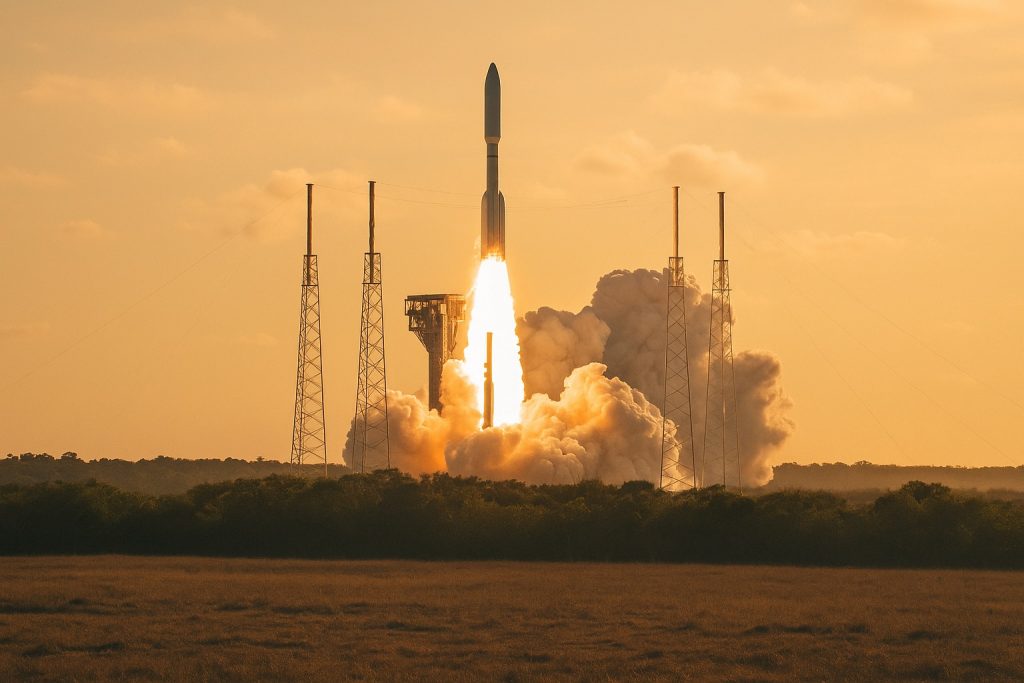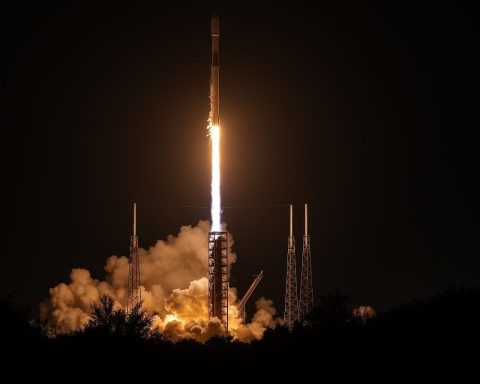- On 17 June 2025, Prof. Wu Jian of Peking University and Dr. Liu Chao of the Chinese Academy of Sciences down-linked 1 Gbps from an unnamed GEO satellite 36,705 km above Earth using a 2-watt laser.
- The AO‑MDR method combines 357 micro-mirrors on a 1.8 m telescope to reshape the wavefront and eight spatial modes, with a path-picking algorithm selecting the three cleanest channels and boosting usable signal probability from 72% to 91% in heavy turbulence.
- The Chinese GEO demo delivered 1 Gbps, about five times the throughput of typical Starlink down-links (100–300 Mbps, peaks ~600 Mbps) from 550 km altitude, with the GEO path about 60 times longer.
- Analysts say the key takeaway is power-per-bit from GEO rather than raw speed, noting Starlink’s 100 Gbps cross-links and Chinese startups’ 400 Gbps inter-satellite tests.
- Chinese military journals frame optical links as low-probability-of-intercept communications and a stepping-stone to directed-energy weapons, while US Space Force General Chance Saltzman warns lasers could damage satellite structures.
- Reuters reports China plans 43,000 LEO satellites across the Qianfan (SpaceSail) and Guowang programs to occupy orbital slots and challenge Starlink in the Global South.
- Analysts say a gigabit GEO feeder link could let GEO operators pair with small regional LEO caches, undercutting capital expenditure per subscriber for large constellations.
- Wu Jian described AO‑MDR as “ground-breaking” for enabling candle-power lasers to punch through turbulence at gigabit rates.
- Limitations include a single-satellite test with no months-long throughput data, reliance on clear skies at Lijiang, and the use of a 1.8 m telescope rather than consumer hardware.
- Future steps include power-scaling experiments by Chinese labs, Starlink hardening with sensor hoods and evasive scripts, UN space-threat norm discussions, and Western GEO operators pursuing low-power optical down-links within about two years.
A Chinese team has just fired a laser “no brighter than a candle” from geostationary orbit (GEO) and moved one gigabit of data per second—roughly five times what Starlink typically delivers—proving that low‑power optical links can beat today’s largest low‑Earth‑orbit (LEO) constellation on both speed and altitude. Behind the headline is a deeper story of adaptive‑optics wizardry (the new AO‑MDR synergy technique), China’s megaconstellation push, and a rapidly escalating security contest in space. Below is a comprehensive, source‑rich explainer that unpacks how the demo works, why experts disagree on its significance, and what happens next.
1. What exactly did China do?
- On 17 June 2025, researchers led by Prof. Wu Jian (Peking University of Posts & Telecom) and Dr. Liu Chao (Chinese Academy of Sciences) down‑linked 1 Gbps from an unnamed GEO satellite 36,705 km above Earth using a 2‑watt laser—“dim as a night‑light.” [1] [2]
- The feat relied on adaptive optics + mode‑diversity reception (“AO‑MDR”), boosting usable signal probability from 72 % to 91 % even in heavy turbulence. [3]
- Newsweek first framed the satellite as “ground‑breaking” and “five times faster than Elon Musk’s Starlink.” [4]
Wu Jian: The AO‑MDR method is “ground‑breaking, allowing a candle‑power laser to punch through turbulence at gigabit rates.” [5]
2. How does AO‑MDR work?
| Optical step | What happens | Why it matters |
|---|---|---|
| Adaptive optics (AO) | 357 micro‑mirrors on a 1.8 m telescope reshape the distorted wavefront in real time. | Cancels most atmospheric blur. [6] |
| Mode‑diversity reception (MDR) | Laser light is split into eight spatial modes; software picks the three cleanest channels each millisecond. | Collects energy normally lost to scattering. [7] |
| Path‑picking algorithm | Selects optimal modes to keep bit‑error‑rate low at only 2 W. | Enables high speed with minimal power. [8] |
In essence, AO gives the beam a sharper focus while MDR scoops up energy the turbulence would waste—together they deliver GEO‑class bandwidth with pocket‑torch power.
3. Starlink comparison: apples, oranges, or hand grenade?
- Typical consumer Starlink down‑links are 100–300 Mbps (peaks ~600 Mbps), delivered from 550 km‑altitude satellites. [9]
- The Chinese GEO demo hit 1 Gbps—≈5× the throughput despite a path 60 times longer. [10]
- SpaceX already flies 100 Gbps in‑orbit laser cross‑links between Starlink craft, and Chinese startups report 400 Gbps inter‑sat tests, so the novelty is power‑per‑bit from GEO, not raw speed, argues IEEE Spectrum’s Andrew Jones. [11]
4. Why speed isn’t the only story
4.1 Dual‑use implications
Chinese military journals frame optical links as a route to low‑probability‑of‑intercept communications and also a stepping‑stone to directed‑energy weapons. [12] [13]
Gen. Chance Saltzman, US Space Force: The PLA has already fielded lasers that “disrupt, degrade or damage satellite sensors” and may soon scale power “high enough to physically damage satellite structures.” [14]
4.2 Constellation chess
Reuters notes China plans 43,000 LEO satellites across projects such as Qianfan (“SpaceSail”) and Guowang, explicitly to “occupy as many orbital slots as possible” and challenge Starlink’s reach in the Global South. [15]
4.3 Commercial shake‑up
Analysts say a gigabit GEO feeder link could let GEO operators pair with small regional LEO caches, undercutting massive constellations on capex per subscriber. [16]
5. Expert scorecard
| Expert | Takeaway | Source |
|---|---|---|
| Wu Jian (PKU) | AO‑MDR is “ground‑breaking.” | [17] |
| Andrew Jones (IEEE Spectrum) | Bandwidth leap is “incremental, not revolutionary”; precision pointing within 5 µrad is the big deal. | [18] |
| Gen. Saltzman (USSF) | Chinese DEWs could soon physically damage satellites. | [19] |
| Chaitanya Giri (ORF) | China’s goal is to “occupy as many orbital slots as possible.” | [20] |
| Daily Galaxy editors | Demo “pulverizes Starlink”—language some experts call hype. | [21] |
6. Limitations and healthy skepticism
- Single‑sat test – No continuous throughput data over months yet. [22]
- Atmospheric windows – Clouds still block optical beams; the Chinese team used a clear‑sky site in Lijiang. [23]
- Terminal cost – 1.8 m telescopes are hardly “user dishes”; miniaturisation remains unsolved. [24]
- Security optics – A 2 W comms laser is not a 20 kW weapon, but power‑scaling research is public. [25]
7. What happens next?
- Power‑scaling experiments: Chinese labs are already publishing concepts for kilowatt‑class space lasers. [26]
- Starlink hardening: Expect mirrored sensor hoods and evasive manoeuvre scripts in future satellites. [27]
- UN norms push: The Open‑Ended Working Group on Space Threats is likely to revisit reversible laser jamming versus destructive attacks. [28]
- Commercial pilots: Western GEO operators eye low‑power optical down‑links within two years, riding the same AO‑MDR concept. [29]
8. Bottom line
China’s 2‑watt laser demo did not “destroy” Starlink, but it did show that clever optics can turn a trickle of GEO photons into a gigabit stream—something many believed impractical. In an era where every jump in space‑bandwidth doubles as a military signal, the achievement is both a telecom milestone and a strategic warning shot. Whether the future internet is beamed by tens‑of‑thousands of LEO craft or by a handful of precision GEO lasers may depend on how quickly rivals replicate—and regulate—this “night‑light” breakthrough.
Sources used (selection)
- Newsweek, SCMP, Interesting Engineering, Times of India, Economic Times, Business Today, Daily Galaxy, Samaa TV, Mezha Media, Reuters, Defense One, U.S.–China Commission testimony, SpaceNews, The Sun, TS2 Tech.
References
1. www.scmp.com, 2. interestingengineering.com, 3. interestingengineering.com, 4. www.newsweek.com, 5. ts2.tech, 6. interestingengineering.com, 7. interestingengineering.com, 8. interestingengineering.com, 9. ts2.tech, 10. timesofindia.indiatimes.com, 11. ts2.tech, 12. www.defenseone.com, 13. www.uscc.gov, 14. www.uscc.gov, 15. www.reuters.com, 16. ts2.tech, 17. ts2.tech, 18. ts2.tech, 19. www.uscc.gov, 20. www.reuters.com, 21. dailygalaxy.com, 22. samaa.tv, 23. interestingengineering.com, 24. mezha.media, 25. m.economictimes.com, 26. www.defenseone.com, 27. www.twz.com, 28. spacenews.com, 29. ts2.tech










